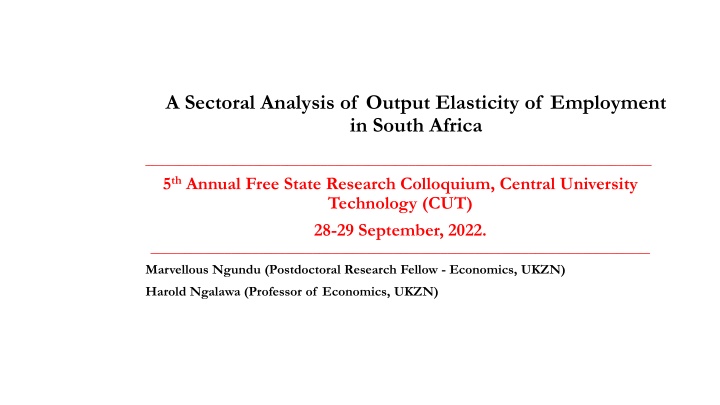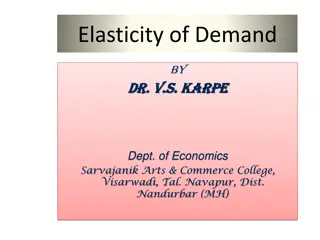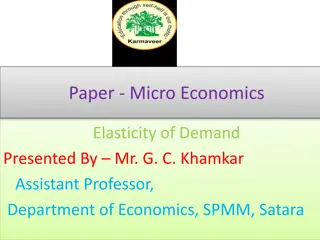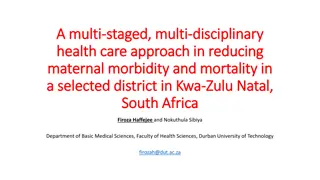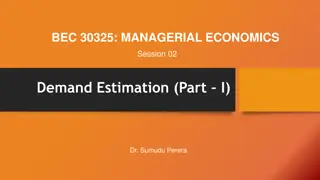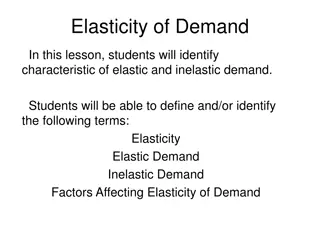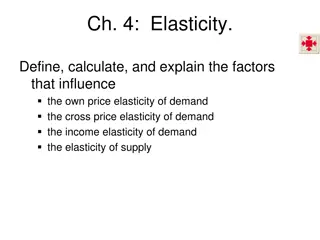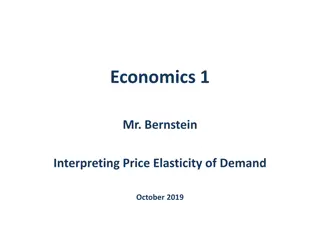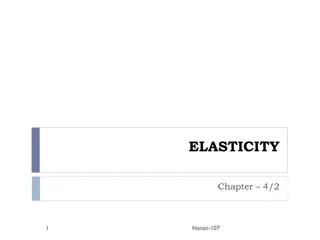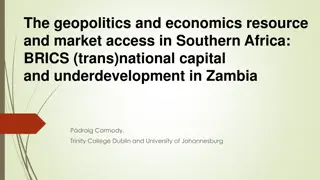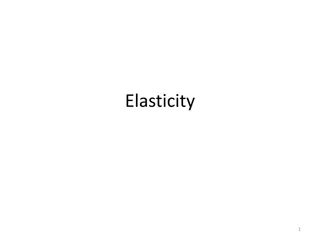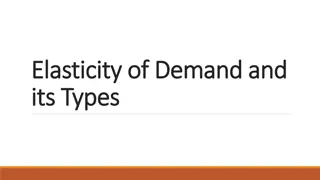Sectoral Analysis of Output Elasticity in South Africa
Explore a sectoral analysis of output elasticity of employment in South Africa, delving into the country's unemployment crisis, empirical findings, and the discussion surrounding the attainment of the National Development Plan's 2030 unemployment goal.
Download Presentation

Please find below an Image/Link to download the presentation.
The content on the website is provided AS IS for your information and personal use only. It may not be sold, licensed, or shared on other websites without obtaining consent from the author.If you encounter any issues during the download, it is possible that the publisher has removed the file from their server.
You are allowed to download the files provided on this website for personal or commercial use, subject to the condition that they are used lawfully. All files are the property of their respective owners.
The content on the website is provided AS IS for your information and personal use only. It may not be sold, licensed, or shared on other websites without obtaining consent from the author.
E N D
Presentation Transcript
A Sectoral Analysis of Output Elasticity of Employment in South Africa ___________________________________________________________________________ 5thAnnual Free State Research Colloquium, Central University Technology (CUT) 28-29 September, 2022. __________________________________________________________________________ Marvellous Ngundu (Postdoctoral Research Fellow - Economics, UKZN) Harold Ngalawa (Professor of Economics, UKZN)
OUTLINE Introduction South Africa s unemployment crisis What the literature tell us about South Africa s unemployment crisis Empirical Strategy Findings Discussion of the findings Conclusion
INTRODUCTION National Development Plan (NDP) s unemployment goal Actual Attained? 2020 14% 32.5% in Q4:2020 X 2030 6% ? ? The unemployment rate in the Q1:2022 was 34.5%, almost 6 times higher than the 2030 targeted maximum threshold. Is NDP s 2030 unemployment goal attainable?
SOUTH AFRICAs UNEMPLOYMENT CRISIS 1400.00 40.00 Unemployment rate (%, seasonally adjusted) 35.00 1200.00 real GDP (R millions, seasonally adjusted) 30.00 1000.00 25.00 800.00 20.00 600.00 15.00 400.00 10.00 200.00 5.00 0.00 0.00 2008-01-01 2008-04-01 2008-07-01 2008-10-01 2009-01-01 2009-04-01 2009-07-01 2009-10-01 2010-01-01 2010-04-01 2010-07-01 2010-10-01 2011-01-01 2011-04-01 2011-07-01 2011-10-01 2012-01-01 2012-04-01 2012-07-01 2012-10-01 2013-01-01 2013-04-01 2013-07-01 2013-10-01 2014-01-01 2014-04-01 2014-07-01 2014-10-01 2015-01-01 2015-04-01 2015-07-01 2015-10-01 2016-01-01 2016-04-01 2016-07-01 2016-10-01 2017-01-01 2017-04-01 2017-07-01 2017-10-01 2018-01-01 2018-04-01 2018-07-01 2018-10-01 2019-01-01 2019-04-01 2019-07-01 2019-10-01 2020-01-01 2020-04-01 2020-07-01 2020-10-01 2021-01-01 2021-04-01 2021-07-01 real GDP in ZAR Unemployment rate (%): Aged 15-64 Figure 1: South Africa s Unemployment GDP relationship for the period (Q1: 2008 Q3: 2021). Source: Authors computation using FRED Economic data.
WHAT THE LITERATURE TELL US ABOUT FIGURE 1 Okun s Law (1962) a country's output growth must be approximately 3% above the nominal rate in a year to achieve a 1% point increase in employment. Jobless Growth Figure 1: tends to be a threat to inclusive growth, resulting in poverty, inequity and social unrest (Dada, 2018). approximately 55.5% of South Africa s population lives below the national upper-bound poverty line, while the income distribution as measured by the Gini index stood at 63.3% (Word Bank, 2020). July 2021 civil unrest. Main cause of Jobless growth in South Africa: Structural reforms 1. Industrialization (structural shifts from labour- to capital intensive) decreased labour demand and job loses (Mkhize, 2019; Altman, 2006). 2. Education reforms to promote human capital through education influx of secondary and tertiary graduates into the labor market. A combination of points 1 and 2 surplus labour force in the market due to the accumulation of new entrants and job losses. South Africa s QLFS statistics show that job losers and new entrants increased by approximately 50.4% and 38.4%, respectively, from the first quarter of 2008 to the first quarter of 2019.
SO WHAT? Mkhize (2019) recommended that new employment opportunities can be created through investing in non-agriculture sectors, typically the tertiary sector. Other 1% No schooling 2% Less than primary completed 7% Tertiary 7% Primary completed 4% Secondary completed 33% Secondary not completed 46% Figure 2: Average proportion of South Africa s unemployed population according to the highest level of education for the period (Q1: 2008 Q1: 2019). Source: Authors computation using QLFS data
IMPLICATION OF FIGURE 2 Current South Africa's unemployment phenomenon appears to necessitate the development of policies that will create inclusive skill-based jobs. Without disregarding the contribution of Mkhize (2019), we urge that his recommendation lacks inclusiveness, which is a major shortfall in South Africa s unemployment crisis. People who have completed secondary and tertiary education are less likely to be in informal employment compared to workers who have either no education or completed primary education. (ILO, 2018: 30 April 2018). Several studies suggest that when there is an excess of labour in the market, informality can serve as a cheap alternative to formal employment (see, for example, Adair & Souag, 2018; Blaauw, 2017; Pasipanodya, 2020). Africa seems to have neglected agriculture for non-agriculture sectors, yet, the continent remains an "agriculture-based society and, will need to look to the agriculture sector to generate the bulk of needed employment in the coming years. L autier & Hanson (2013:1). Several studies assert that agriculture-led economic growth is inclusive, and thus has a high potential for creating mass employment in Africa (see, for example, Dada, 2018). Objective of the study: To explore the responsiveness of sectoral employment to changes in the sectoral output of South Africa s agriculture and informal sectors in order to inform policies about the extent of these sectors' labour absorption capacity.
EMPIRICAL STRATEGY Model: Following Mkhize (2019), Ajilore & Yinusa (2011), and Upender (2006), this study utilizes the double-log linear labour demand function (Equation 1) ????= ? + ?1????+ ? ???? + ?? (1) Equation (1) is derived from the constant elasticity of substitution (CES) production function (Equation 2) through solving the marginal product of labour. ? ?where ? > 1, ? > 1, 0 < < 1, and ? > 1 ?+ 1 ?? ? (2) ??= ? ?? Variables: y is the sectorial gross value added (GVA) at factor cost in real terms, L is the employed population in a specific sector, X is a set of regressors that are justified in the literature as vital in explaining labour demand, and is the disturbance term. These regressors include sector- specific nominal wages (seasonally adjusted), the user cost of capital, and the inflation rate. Estimation technique: The study adopted the Engle-Granger two-step testing procedure (Engle & Granger, 1987) to test the null hypothesis of jobless growth (1993-2018) assuming evidence that it exists if there is no cointegration between employment (L) and output (y). A cointegration test is thus a test of whether the OLS residuals have a unit root. H0: The residuals have a unit root: Accepting H0implies that there is no cointegration, thus, confirming jobless growth in that particular sector; otherwise, Okun's law applies.
FINDINGS Table 1: Cointegration Augmented Dickey-Fuller (CADF) test results Economic Sector Residuals' ADF Test: Test Statistics Decision Total Agriculture -1.49 Not cointegrated Formal Agriculture -1.27 Not cointegrated Informal Agriculture -2.37 Cointegrated Informal non-agriculture -2.46 Cointegrated Notes: The critical values for the Engle-Granger cointegration test on regression residuals at 1%, 5%, and 10% are -2.62, -1.95, and -1.61, respectively. The null hypothesis of no cointegration is rejected if the test statistic s value > the critical value at 5% . Source: Authors computation using R. Table 1 shows that the null hypothesis of no cointegration could not be rejected on total agriculture and formal agriculture models, confirming jobless growth. This finding confirms that South Africa's agriculture sector predominantly depends on commercial agriculture. Commercial agriculture has become capital-intensive as a result of agricultural mechanization, therefore, the evidence of jobless growth in the sector is not surprising. On the other hand, we rejected the null hypothesis in both the informal agriculture and informal non-agriculture models, demonstrating Okun's law features in the sectors. This implies that there was a long-run relationship between the informal sector s employment and output for the period (1993 2018). Following the results in Table 1, we estimated Equation (1) in error correction form for both the informal agriculture and informal non-agriculture models to determine the adjusting speed to equilibrium, while the total agriculture and formal agriculture models were estimated within a short-run perspective.
FINDINGS CONTINUED Table 2: Labour demand elasticities in South Africa s agriculture and informal sectors Dependent Variable: Employment/labour demand Constant Total Agriculture 16.19*** (4.40) -0.56 (0.41) 1.11 (0.71) -0.04 (0.21) -1.63 (1.01) Formal Agriculture 15.27*** (5.42) -0.66 (0.50) 1.47 (0.87) 0.09 (0.25) -2.12 (1.22) Informal Agriculture 16.55*** (3.39) -0.25 (0.34) 0.07 (0.40) -0.46*** (0.16) -0.15 (0.77) -0.64*** (0.20) Informal non-agriculture 1.02 (3.01) 1.35*** (0.38) 0.87*** (0.17) 0.46** (0.19) -3.36*** (0.47) -0.86*** (0.29) GVA Wages Cost of Capital Inflation Error Correction Term [ECT(-1)] Summary Statistics: Adjusted R-Squared F-Statistics P(F-Statistics) Estimated Method 0.52 7.68 0.00 OLS 0.60 10.25 0.00 OLS 0.32 3.93 0.02 OLS 096 145.3 0.00 OLS Notes: The ECT(-1) was obtained by fitting VECM in the Engle-Granger 2OLS estimator. ** and *** significant at 5% and 1%, respectively. Standard errors are in parentheses. Source: Authors computation using R Table 2 shows negative and highly significant ECT(-1) values in both informal agriculture (-0.64) and informal non-agriculture (-0.86) models, implying a disequilibrium adjusting rate of 64% and 86% within a year, respectively. However, the informal agriculture sector's employment intensity of output growth is statistically insignificant. This is not surprising considering that informal agriculture in South Africa has been neglected since the 1990s. The findings of the non-agriculture informal sector model show a fairly elastic (1.35%) employment intensity of output growth over the study period, with a statistical significance at 1%. The findings are robust to residual tests performed to confirm the fundamental assumptions of the classical long-run OLS model.
DISCUSSION If we review our findings together with those of Mkhize (2019), we derive that the non-agriculture informal sector is the South Africa s second most labour-intensive sector after the finance and business services sector (1.56%). Control Variables: Cost of capital: High cost of capital discourages potential agri-entrepreneurs and the growth of existing ones. In South Africa agri-entrepreneurs (both start-ups and existing) face capital constraints to finance raw materials, inputs, and operational costs. Although some raw materials can be substituted with labour, such as the use of labour instead of tractors, productivity will be low. However,non-agriculture SMMEs can substitute capital with labour when capital costs are high. This is especially true in South Africa, where the service industry, particularly trade, dominates the informal sector. Thus, an increase in the cost of capital reduces capital demand while increasing labour demand. Wages: Entrepreneurs are drawn to high-paying informal economic activities, and their wages depend on output. Inflation: Inflation raises operating costs, particularly for SMMEs, and thus discourages entrepreneurship.
CONCLUSION Non-agriculture informal sector is South Africa's second most labour-intensive sector (1.35%), after the finance and business services sector (1.56%). In the formal agriculture sector, the employment output relationship appears to have been eliminated by agriculture mechanization which promoted jobless growth in the sector. In line with sustainable development goal (SDG) 8.3, economic policy consciousness on the informal sector, including agri-entrepreneurship, is necessary to create inclusive mass employment, which is an essential missing piece in the puzzle to curb unemployment in South Africa.
